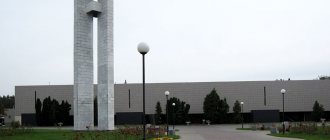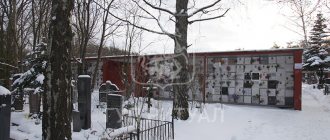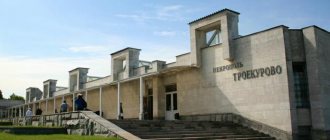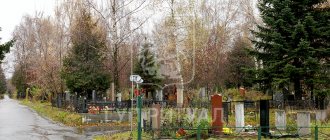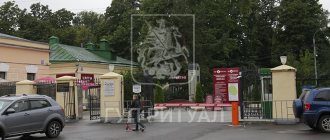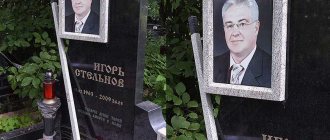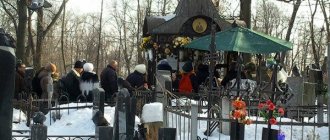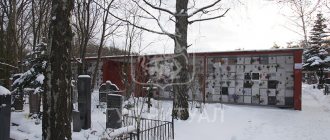Khovanskoye Cemetery is currently the largest cemetery in the capital. It is located in the settlement of Sosenskoye, Novomoskovsk administrative district. The Khovanskoye cemetery got its name from the village of Nikolo-Khovanskoye, near which it was created in 1972. As of 2022, the area of the Khovansky cemetery is more than 197 hectares, and over the past almost half a century since its foundation, a large number of artists, cultural and sports figures have been buried there, some of whom our material will tell about.
Where can I find a list of all those buried at Khovanskoye Cemetery?
Khovanskoye Cemetery belongs to the Ritual company. Employees of this organization service the burial area and maintain archival records of burials, which began during the formation of the necropolis.
Information about those buried can be found in the office, located on the left side of the main entrance.
The cemetery is divided into sectors: Northern, Western and Central.
Please note: in front of the entrance there are information maps indicating plot numbers, with their help it is easy to find the desired grave. There are also three churches where you can order services for the repose of the souls of the departed.
Pavel Evgenievich Smeyan
Pavel Evgenievich Smeyan is a famous Soviet and Russian musician, singer, composer and actor. After graduating from music school, Pavel Smeyan played for some time in city philharmonic societies, in Rosconcert, and also, since the 1980s, participated in the activities of several musical groups and ensembles: “Rock Studio”, “Apostle”, “Black Coffee”. Since 1981, Smeyan also began playing on the stage of the Lenkom Theater at the invitation of Mark Zakharov - his debut was the role of the Chief Writer in the rock opera Juno and Avos. In cinema, Pavel Smeyan’s voice was first heard in the television film “The Trust That Burst.” Subsequently, Pavel Smeyan took part in a large number of films, as well as theatrical productions (especially rock operas). Among other things, Pavel Smeyan also wrote the rock opera “Word and Deed” based on A. K. Tolstoy’s story “Prince Silver” - it was recorded in 2000. Also in the 2000s, Smeyan took part in dubbing computer games. In July 2009, Pavel Smeyan died at the age of 52 in Germany, where he was being treated for pancreatic cancer. He was buried at the Khovanskoye cemetery next to his parents and brother. His grave is decorated with a wooden cross and a color photograph on a stand. Along the perimeter of the grave site there is a border made of gray stone with a black metal fence.
Bus schedule 600 to Khovanskoe Cemetery
Convenient route No. 600 connects the Salaryevo and Teply Stan metro stations. Departing from any point, the passenger will get to the Khovanskoye cemetery.
From Teply Stan the first car leaves at 6 o’clock, and the last at 21-30. You can leave Salaryevo station from 6:30 to 22:00. On weekdays, the wait for the next bus will be no more than a quarter of an hour; on weekends they run much more often.
Stelnov, Igor Anatolievich
Igor Anatolyevich Strelnikov is a famous Soviet and Russian hockey player. His path to big-time sports began with the CSKA sports school, as a result of which he played his first professional matches for this team. In total, during his career, Stelnov took part in 409 matches, became an Olympic champion twice, a world champion once, and also repeatedly won other prizes in prestigious tournaments. From 2004 to 2009, Stelnov acted as a coach of the hockey club of the Ministry of Internal Affairs of the Russian Federation. On March 24, 2009, Stelnov died untimely - he was only 46 years old. His grave at the Khovanskoye cemetery is part of a large family burial ground. This tombstone complex is made of black granite, its main elements are one horizontal and one vertical stele, decorated with photographic portraits and engravings with gold leaf. The vertical stele, which belongs to Igor Stelnov himself, also has an engraving in the shape of a hockey field, and a hockey stick is also attached to it.
Khovanskoe Cemetery Crematorium - directions for motorists
There is a crematorium at the cemetery. There is also a columbarium for the burial of ashes.
Those who want to get here by car should use a navigator. In this case, the final destination must be indicated either “Khovanskoye Cemetery” or “Admiral Kornilov Street, possession 3”.
The route from the Moscow Ring Road, 41 km, is as follows:
- drive along the Moscow Ring Road 280 m;
- right exit onto the street Profsoyuznaya, drive 210 m;
- turn right, drive along the street. Profsoyuznaya 93 m;
- travel along Kaluga highway 1.4 km;
- turn right and drive 1.7 km;
- turn left, drive 460 m;
- turn left again and drive 310 m;
- turn right 210 m;
- and the last left turn is 36 m.
Or drive 45 km from the Moscow Ring Road along the Kievskoye Highway, then turn onto Admiral Kornilov Street. There are appropriate signs along the route.
Alevtina Alekseevna Rumyantseva
Alevtina Alekseevna Rumyantseva is a famous Soviet and Russian film actress. From her school years, Rumyantseva began attending a drama studio, and in 1949 she successfully entered the acting department of VGIK. She made her film debut while still studying, and after graduating from college she began working at the Film Actor's Theater Studio. The most famous films with Rumyantseva’s participation are “Three Poplars on Plyushchikha”, “Carnival”, “On Tomorrow Street”, “Wedding Day will have to be clarified”. Throughout her life, Rumyantseva’s stage role was primarily limited to the roles of “ordinary people”: village women, nurses, teachers, etc. It is believed that Rumyantseva worked most productively under the guidance of director Tatyana Lioznova. Having retired in 1990, Alevtina Rumyantseva then returned to cinema - but already to TV series. Rumyantseva died in 2011; she was 81 years old. Rumyantseva’s grave at the Khovanskoye cemetery is located in the family plot. The red-brown granite stele standing over her grave is decorated only with an engraving with the name and dates of the actress’s life. There are also two flower beds and a wooden cross installed on the site.
November 19, 2020
You might be interested:
- Celebrity graves at Vagankovskoye Cemetery
- Celebrity graves at Novodevichy Cemetery
- Last words before the death of literary heroes and famous people
Celebrity graves at Khovanskoye Cemetery, photo
Tourists' interest in the Khovanskoe cemetery is due to the fact that theater and film actors, athletes, writers, heroes, and honored scientists are buried here. It is quite common to see famous names carved on monuments.
Particular interest in the burials on Khovanskoye is caused by the famous Orekhovskaya Alley. In this part of the cemetery there are graveyards with majestic tombstones, perpetuating the memory of participants in the criminal group of the 90s, headed by Sergei Timofeev.
Negovsky, Vladimir Alexandrovich
Vladimir Aleksandrovich Negovsky is one of the founders of Soviet resuscitation. Negovsky received a medical education and since 1934 worked in his specialty in the pathophysiological laboratory of the Institute of Blood Transfusion. Taking part in the experiments carried out in this laboratory to return dying organisms to life, Negovsky became fascinated by the idea of developing other methods of combating death and wrote to the Chairman of the Council of People's Commissars of the USSR with a request to provide him with a laboratory in which he could conduct his own experiments in this area. It was Negovsky’s work that formed the basis of Soviet resuscitation, since in the course of his experiments he proved that clinical death is not final death and that a person can be brought back to life if the process of heart fibrillation is stopped. Negovsky's innovative theory, which was later confirmed, was that cardiac arrest does not mean the death of a person and that true death is brain death. Therefore, as long as the brain remains alive, a person's heart can be restarted and brought out of the state of clinical death. During the war, Negovsky repeatedly went to the active army and brought the seriously wounded back to life, and in the post-war years he expanded his activities and created a clinical resuscitation center. In total, Negovsky led several organizations that were in one way or another involved in resuscitation. In 1985, with his participation, the world's first Scientific Research Institute of General Reanimatology (NIIOR of the USSR Academy of Medical Sciences) was opened. Great experience in dealing with death probably benefited Negovsky, since he lived a very long life and died only at the age of 95. His grave at the Khovanskoye cemetery is surrounded by a white stone border and a black metal fence; the tombstone is a stele made of Karelian gabbro-diabase with a wavy upper edge.
Vagankovskoye Cemetery - authorities
But it was precisely this force that caused their death. On August 6, 1993, Amiran Kvantrishvili, together with thief in law Fedya Besheny, was shot dead in an office on Dimitrova Street in Moscow. A year later, the killer of the Orekhovskaya organized crime group, now well-known Alexei Sherstobitov, near the Krasnopresnensky baths, cut short the life of his brother, chairman of the Lev Yashin Athletes Fund, Otari. Then even Russian President Boris Yeltsin sent condolences to the family of the deceased. It is not surprising that Otari’s funeral was attended by a huge crowd of people.
Grave of brothers Otari and Amiran Kvantrishvili
People such as Joseph Kobzon, Archil Gomiashvili, Ivan Yarygin and others came to honor his memory. The brothers were buried at the prestigious and long-closed Vagankovskoe cemetery. Their grave at the main entrance has long become a landmark of the churchyard. A huge angel with a mournful face reaches out to two granite tablets on which the names of the brothers are inscribed. For the uninformed, it is worth noting that the monument is not just a hack job by an unknown master, but a work belonging to the chisel of the famous sculptor Vyacheslav Klykov. Among his works is a monument to Cyril and Methodius, Marshal Zhukov, Ivan Bunin, Dmitry Donskoy and other celebrities.
The Vagankovsky churchyard became the last refuge for the authority of Vitya Ryazansky, the head of the most powerful organized crime group in Ryazan, Viktor Airapetov.
On November 19, 1995, on Rublevskoye Highway, Airapetov’s car was stopped by fake riot police and taken away by mafiosi in an unknown direction.
Grave of Viktor Airapetov
His charred corpse was later identified by his wife. Although experts insist that it was a staged act, the black granite obelisk with a massive fence claims that this is where the leader of the criminal Ryazan is buried. However, there are rumors that already in the 2000s, Vitya came here in person and even laid flowers at his monument.
Banykinskoe cemetery - bandits
Another famous bandit graveyard is the Banykinskoye cemetery in Togliatti. In the mid-90s, a real criminal war broke out in the motor city.
Bandits died here by the dozens a day, and the cemetery gates were almost never closed. The lads were buried depending on their rank. Thus, the central alley of the churchyard is occupied by the graves of the leaders and foremen of numerous organized crime groups: Dima Ruzlyaev, the Kupeev brothers, the Bukreev brothers.
Grave of crime boss Dima Ruzlyaev (Dima Bolshoy)
The Banykinskoe cemetery amazes not so much with the pathos of the obelisks, but with the mass of burials. By the way, among these fallen gangsters you can hardly find those who lived to be thirty. At the moment, the Tolyatti authorities are thinking about organizing a tourist route to the Banykinskoye cemetery under the sign “Tolyatti - Russian Chicago.” However, similar burials can be found in the cemetery of any major city in Russia, because the dashing 90s left unhealed wounds on the body of the entire country.
